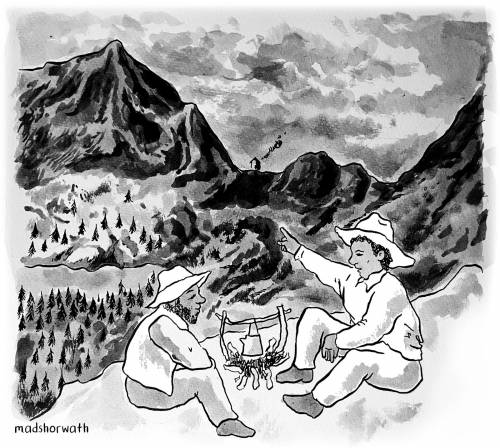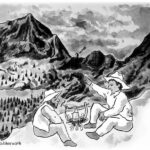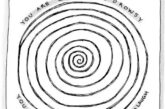When I was a child, my grandmother and I played a game that involved walking around her neighborhood pretending to be aliens, from a planet called Algernon, trying to discern the nature of every object we saw. That garden hose? It was a snake that spewed poisonous tears from its rusty mouth. Those tree roots? They were the knobby fingers of a giant sleeping under the sidewalk.
Nothing has brought back the thrill of these walks—the pleasures of excavating strangeness from banality—as sharply as reading the prose of Kathryn Scanlan, who describes a suburban home and its back-yard playhouse as “two of the same animal, large and small, grown and juvenile,” or an ordinary tart as a wild creature at rest: “The thing I’ve made is resting. It has a powder I don’t like to disturb, but I cut it apart and set it between us.” The “thing” and its eerie pronouns, the casual violence of its dissection, the lurking beast-baby of a playhouse—all these turns of phrase are saturated by the quiet menace that Scanlan brings to her estranging evocations of daily life. Scanlan makes art about ordinary living—ordinary people, ordinary days, ordinary events—by distorting it: she distorts narrative arcs by alighting on jagged arrangements of anecdotes, distorts her descriptions with unsettling comparisons, and distorts time by stretching it like taffy or compressing it into searing instants. Her work traffics in moments and lifetimes, but rarely in the in-between units (days, weeks, years) that compose most narratives.
Scanlan’s books are hard to slot into traditional genre categories. Her début, “Aug 9-Fog,” which appeared in 2019, consists of fragments whittled from a diary that Scanlan found at an estate sale. It recounts a year in the life of an eighty-six-year-old woman in rural Illinois, seasons spent tending a home and nursing a dying husband: “He called. Not so good. Bleeding again. Trying to knit pincushion.” The next year, Scanlan published a collection, “The Dominant Animal,” that shrank the short story to its barest bones: forty stories in just a hundred and forty pages. These narrative shards lay bare the menace and desperation lurking inside mundane moments: a boy sticking his hand between his cousin’s legs; a constipated boyfriend trying to eat enough salami to “force it out”; a daughter bending to pick up her mother’s stray white hairs after the overdue installation of an air-conditioner. (“It couldn’t help her because she was dead.”) Animals are everywhere—as mysteries, nuisances, accomplices—but the human characters, as the book’s title suggests, are the most animal of all. The stories are wry, startling, and feral, full of malice and hunger, where “Aug 9-Fog” is full of pragmatism, curiosity, and quiet engines of domestic wonder.
Scanlan’s new book, “Kick the Latch” (New Directions), interlaces the dark threads of violence that run through “The Dominant Animal” with the unsentimental rituals of caregiving that anchor “Aug 9-Fog.” “Kick the Latch” is perched ambiguously between novel and oral history. In an author’s note, Scanlan calls it a “work of fiction” based on interviews that she conducted with an Iowa-born horse trainer named Sonia. The book narrates Sonia’s life in a series of vignettes that play out across the gritty, intoxicating fever dream of the horse-racing world, as Sonia travels from race to race, living in trailers and motels. It’s a landscape full of exhausting labor and habitual violence, but also ecstatic devotion and joy. Sonia trains a one-eyed horse named Dark Side to victory; a racetrack band called the Bug Boys (jockey singer, trainer drummer) plays at local bars; priests come to bless the legs of the horses. Fleeting characters are sketched with unsparing but often fond attention: “Thorby was gentle but when he got drunk he’d pick a fight with a cigarette machine or a jukebox.”
The idea that ordinary life can be the subject of great art has long been accepted when it comes to poetry and literary fiction—in these genres, its status as a worthy subject feels self-evident—but it can still raise hackles in creative nonfiction. An invented life can be ordinary, but an actual life had better be seasoned by either extraordinary suffering or particular achievement. Scanlan, however, is almost insistently drawn to ordinariness. The shortest vignette in “Kick the Latch” is titled “Racetrackers,” and it’s just a single sentence: “You’re around some really prominent people and some are just as common as old shoes.” Sonia’s own allegiance is clear—to the old shoes, the jukebox fighters, and the Bug Boys.
In all her books, Scanlan writes about ordinary life in extraordinary ways by compacting it radically, like pressurizing carbon into diamonds. When Sonia describes the force absorbed by a single hoof in every stride of a horse’s gallop—“a thousand pounds of pressure held up by that one thin leg”—she could also be describing Scanlan’s syntax: compact phrases holding so much pressure. The work is structured by recurring themes: the violence and pleasures of intimacy, the balm and exhaustion of hard work, our bonds with animals and with our own animal natures—those surges of desire and aggression that unseat and rearrange us.
But the effect of Scanlan’s work rises as much from its form as from its content. As with a sculpture, you’d be as likely to describe it in terms of its shape as its materials. Reading Scanlan often feels like encountering something akin to Wallace Stevens’s jar on a hill (“it did not give of bird or bush”): forceful in its presence but hard to penetrate, self-contained and opaque. “I try to write a sentence as unbudging and fully itself as some object sitting on a shelf,” she has said. Her prose has a cool efficiency, the kind of spare disclosure that makes you feel ashamed to want more, as if you were asking for a third serving of dessert. Her minimalist style accomplishes a sleight of hand. At first glance, her compression seems to elide the evidence of its making—reticent in its concision, rather than broadcasting its artifice. Yet this radical brevity ultimately demands that we see it as a crafted thing. The efficiency is both graceful and aloof. The crude repetitions of need and desire become elegant asides; the mess of years becomes a single sentence.
Scanlan, who is forty-two, lives in Los Angeles but grew up in Iowa. Her mother came from a family of farmers, her father from a family of racehorse trainers—the itinerant world of races, jockeys, and groomers that Scanlan takes up in “Kick the Latch.” Her writing sits at the confluence of two artistic lineages: the art of the ordinary and the art of distillation. One is a tradition of form, the other of content. She is an inheritor of the poignant terseness of Lydia Davis and Diane Williams (she has been published many times in Williams’s literary journal, NOON) but also of the documentary poetry of Charles Reznikoff and Muriel Rukeyser, the rural dramatic monologues in Edgar Lee Masters’s “Spoon River Anthology,” and the grotesque character sketches of Sherwood Anderson’s “Winesburg, Ohio.” Scanlan has cited Walker Evans’s declaration that his “photography was not ‘documentary’ but ‘documentary style,’ ” and her description of this aesthetic could also describe her own: it gives off “the raw, immediate feel of the unedited everyday,” but “you quickly realize how shaped it is.”
In “Kick the Latch,” Scanlan’s anecdotes (with titles such as “Pickled Boiled Eggs,” “Call Your Owners, Call Home,” and “Gallon of Blood”) do not unfold quite like a traditional plot, with deepening relationships and a narrative arc. They are more like rosary beads, each a tiny, contained unit. Born in 1962, Sonia starts working full time at a horse farm just after she graduates from high school, travelling the circuit with her “racetrack family”—a greenhorn amid seasoned “grooms, jockeys, trainers, racing secretaries, stewards, pony people, hot walkers, everybody,” all of them hitting the same grocery stores, laundromats, and bars at every stop, for every race. Sonia’s life is bound by the constant, gruelling rhythm of her work: “Four o’clock feed, seven days a week.” The jockeys are experts at starving themselves for minimum weight and maximum velocity, a process that feels not entirely dissimilar to Scanlan’s craft: “The jockeys flip their food or they don’t eat at all. They get so good at puking they brag about it—I can flip the rice but leave the beans! ” This is Scanlan’s particular skill: flipping the rice but not the beans. Getting rid of all the language that isn’t absolutely necessary but keeping the essential details that fuel the text, and give it life. The visceral specificity of her writing, by refusing to sanitize our physical presence in the world, makes the ordinary strange. It’s like saying a familiar word so many times that it starts to sound as if it were from a foreign language.
Sonia emerges as a compelling character: kind beneath her gruff exterior, charmed by surprising things (a Thanksgiving turkey roasted in a motel bathroom, for example), dry as a bone and cool as a cucumber, consistently understated about her own pain. Describing a riding accident that puts her in a coma, she says simply, “I was at the bottom of the pile.” When Sonia eventually leaves the racetrack life, she moves back home to take care of her ailing parents and ends up working as a corrections officer at a maximum-security prison. “I tried to be a normal person,” she explains. Yet the racetrack still occupies what W. B. Yeats might call her deep heart’s core. “People say you never get racing out of your blood,” she remarks. “I still dream about it most nights.”
Whenever Sonia is talking about horses, tenderness cuts through her stoicism like vinegar through oil. She describes birthday celebrations for her horse Rowdy (“frosting on his muzzle”) and nursing a “skin and bones” mustang named Chico, rescued from a rodeo sale: “I got some weight on him, some calm.” She has a soft spot for underdogs who have been cast aside, mistreated, reviled, or deemed unworthy of care, from horses like Rowdy and Chico and Dark Side to the incarcerated men at the prison where she works. Or like the drunk grandpa who lived on her block when she was young; she let him stay in her room when his daughter kicked him out.
The longest vignette in the book describes Bicycle Jenny, a figure from Sonia’s childhood, a woman whose house burned down:
What was left of her house was a scorched concrete hole in the ground. That’s where she lived. . . . She had clothes-pins and wire hanging from trees. Down in her hole in the ground was an old-fashioned bathtub and a little cast-iron camp stove. She had test tubes with rubber stoppers, little blue bottles, jars of jellies she made from her raspberry bushes. . . . Her voice was high, cracked, eerie like a witch’s. She had her big men’s work gloves, her hat and her other hat, and she’d usually have some chihuahuas stuffed in her coat.
In her burned-out home, Bicycle Jenny keeps an incredible number of “little yipping chihuahuas”; Sonia remembers “sixty, seventy chihuahuas without stretching it a bit.” The extended memory of Bicycle Jenny not only allows us to register Sonia’s tough-minded empathy (“How’d they not freeze in the winter? I didn’t think nothing of it when I was a kid but I’m thinking of it now — how’d the dogs survive?”) but also illuminates how our lives are often shaped by seemingly unimportant figures, the kinds of relationships and moments that are frequently overlooked. Bicycle Jenny takes up more textual room than any of Sonia’s romantic partners or family members, more room even than the racetrack accident that leaves her in a coma.
When life becomes art, it can honor the disproportionate impact of those peripheral moments and figures which end up composing us—even if we have no ready-made language for their influence. Bicycle Jenny mattered because she survived and bore her hardship without a fuss, because she was a woman with nothing but a charred hole in the ground who made jam anyway—and took care of those chihuahuas, who somehow survived the winter.
In a vignette called “I Seen Him Every Day,” Sonia describes a man breaking into her trailer in the middle of the night when she was a teen-ager: “He was taking pills. He was a jockey trying to cut weight. He told me he’d just shot a dog.” He puts a gun to her head. She says, “I got raped,” and not much more than that—to anyone in her community, or to the reader. In closing, she says only, “The guy sobered up, I knew him, I seen him every day, I knew exactly who it was—it was bad, but anyway, I survived. I cut my hair real short after that.”
This is trauma stripped to its essentials: the silence, the daily exposure, the curt “it was bad,” the shorn hair as a wordless articulation of damage. The title “I Seen Him Every Day” reveals the handprint of an author who is explicitly absent from these pages but is always choosing what to include and what to leave unsaid, what to juxtapose, where to end. The title forces us to spend a moment longer in that dimension of Sonia’s trauma—to acknowledge it. No introspection or catharsis, only the hair cut “real short,” and the white space afterward—so that everything unsaid can fill the silence.
Sonia’s penchant for understatement and Scanlan’s stylistic compression go hand in hand, tonal collaborators, to the point where it becomes hard to tell if Sonia’s consciousness—the understatement that seems so crucial to her character—is a function of her own sensibility or of Scanlan’s. But does it matter? In these pages, Sonia is a character, not a faithful representation of a person in the world beyond.

“It may be easier to brew it here, but I say we go to that expensive coffee shop over yonder.”
Cartoon by Mads Horwath
Wherever it comes from, this compression amplifies the effect of violence rather than diluting it—the way a blade gets sharper the more precisely it’s ground. No extra words offer solace, distraction, or epiphanic recuperation. This violence is often gendered: a horse owner forces a new girl to jerk off his stallion while bystanders gawk; Sonia’s ex-lover Mister Baker tries to strangle her, stalks her, and then kills her cat. Gendered violence also courses through “The Dominant Animal,” from the casual degradation of an offhand phrase (“I bet you like to fuck”) to the malicious amusement that a girl observes in a group of boys as they hold her underwater (“I understood this as their birthright”). Over and over again, characters turn back to the very things that harm them, refusing plotlines of resolution or catharsis. These stories are about living alongside darkness. When a woman calls her doctor after expelling the “clotted, rotted wad of gauze” that he used to stop her bleeding after giving birth, she tells him, “I think you forgot something.” He replies, “You survived, didn’t you?”
Sonia, too, has survived. In her short sentences, we can hear both the imperative to simply endure all this violence (“I seen him every day”) and the rage of enduring it. The day after Mister Baker attacks Sonia—leaving her gurgling blood, with bruises around her neck—the police release him from jail, informing her, “This is just to let you know that Mr. Baker—Mister Baker—has been released.” The italics belong to Sonia, and the title “Mister Baker” belongs to Scanlan: both female narrators are calling him to task, exposing his violence, and insisting on the dignity of saying exactly as much as they’d like about him, nothing more.
The relationship between Sonia and Scanlan, subject and writer, becomes briefly explicit near the end of the book, when Sonia, for the first time, addresses a “you”: “This week I’ve been busy, but I’ve got to get those pictures of Rowdy in the mail for you.” In this turn toward the “you”—an address that could easily have been excluded from the text but was instead preserved—we are reminded of the interview process that Scanlan has told us about. The “you” of Scanlan has been shaping the story all along, of course, choosing, arranging, and perhaps even transforming everything we see.
In the closing lines of the book, Sonia observes that “a racetracker doesn’t say We won a race. A racetracker says We win. It’s not proper English. . . . The race is over, it’s already won, but we say We win, we win, we win.” Every world develops its own ways of speaking. Every experience demands its own ways of being spoken. This text, in its final breath, invokes the literary present tense—like a spell, or an incantation. Once a life becomes text, it no longer has a body. But it can live forever. ♦
Sourse: newyorker.com






